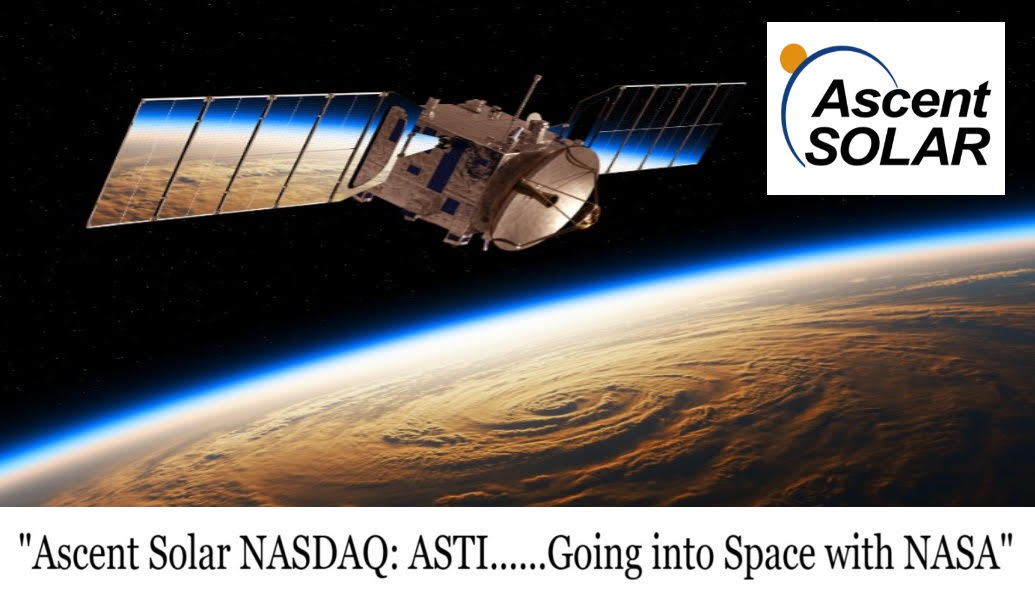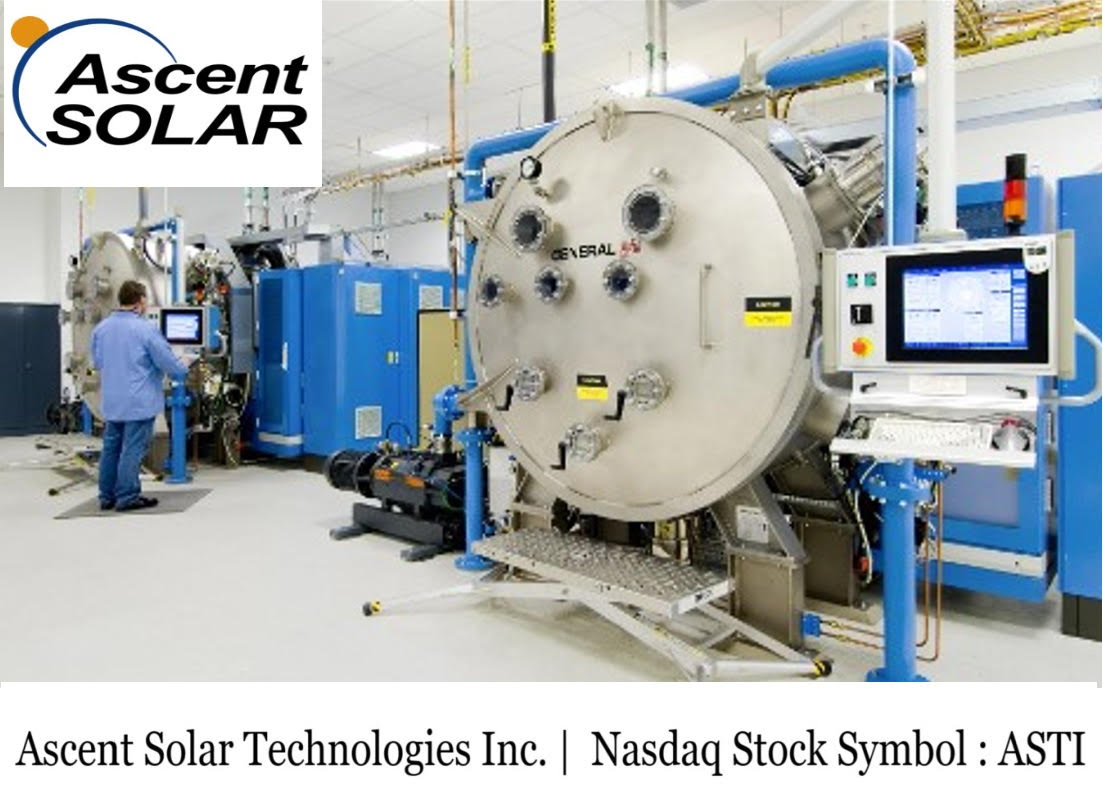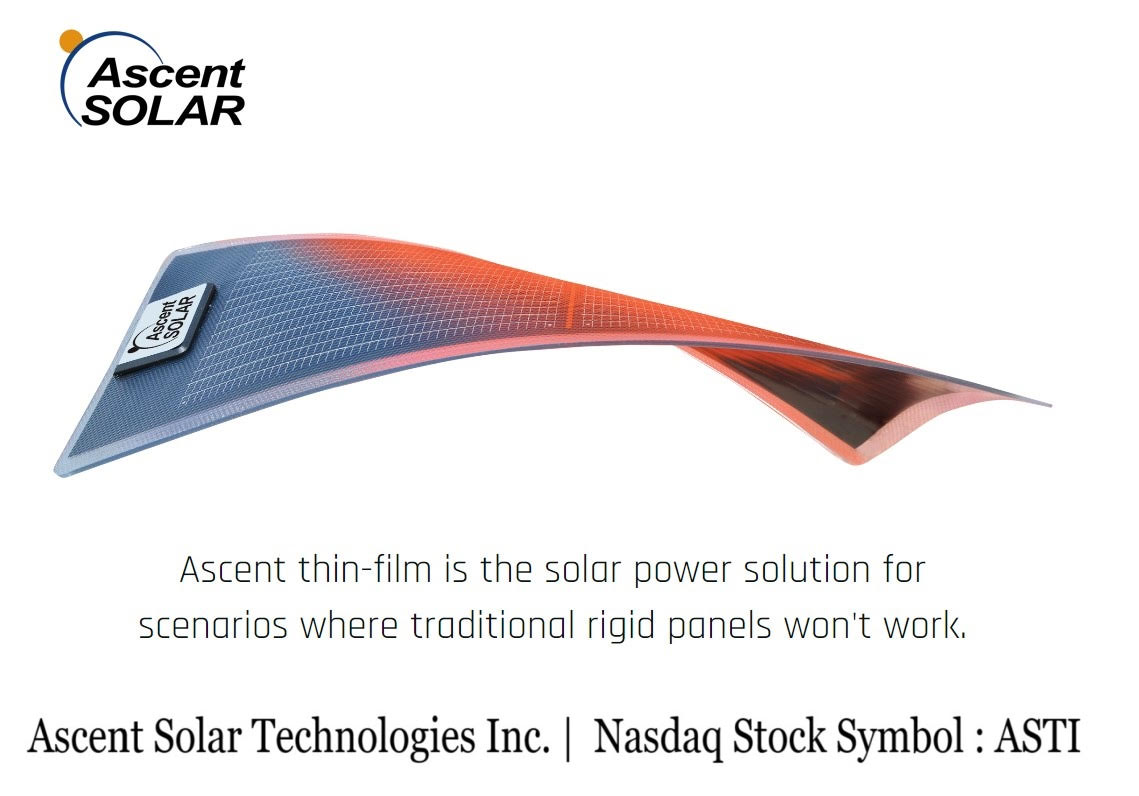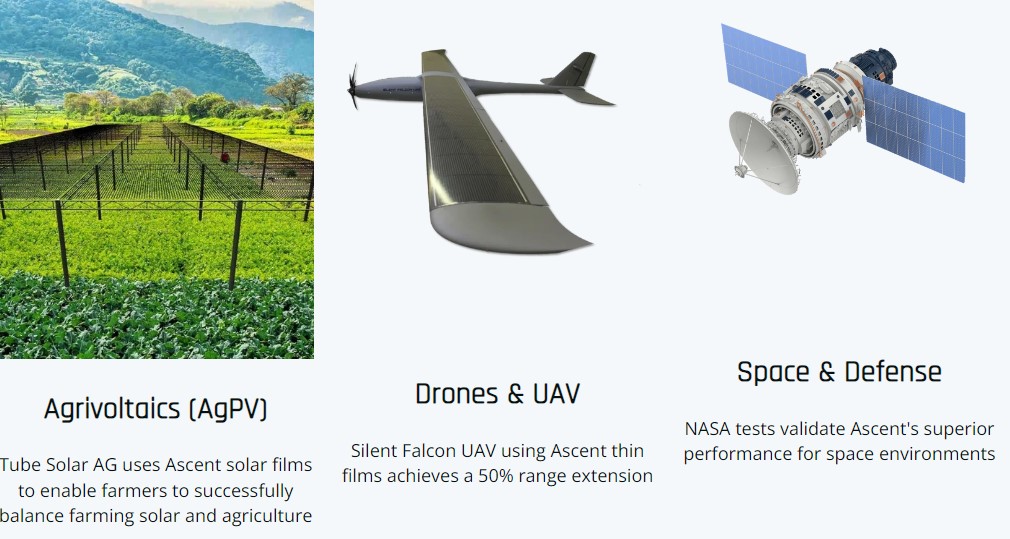Trending...
- $5 - $20 Million in Sales for 2026; $25 - $40 Million for 2027 Projected with NASA Agreements; New MOU Signed to Improve Solar Tech in Space - 518
- Only 7 Days Left for Early Bird Registration to the OpenSSL Conference 2025 - 158
- CCHR Warns Global Survey Confirms Electroshock Risks Hidden From Public - 152
Ascent Solar Technologies, Inc. (N A S D A Q: ASTI) $ASTI Thin Film CIGS Solar Tech has Key Applications in Aerospace, Agrivoltaic Installations, Industrial/Commercial Construction and Consumer Goods
THORNTON, Colo. - Californer -- Provider of Innovative, High-Performance, Flexible Thin-Film Solar Panels for Environments Where Wass, Performance, Reliability and Resilience Matter.
Successful Applications in Space Missions, Aircraft, Agrivoltaic Installations, Industrial/Commercial Construction and Consumer Goods.
Research and Development Center and 5-MW Nameplate Production Facility Strategically Located in Thornton, Colorado.
Multiple Strategic Partners in the Space Market, Including a Major Defense Contractor, Multiple Deployable Technology Companies and a Satellite Company.
Teaming Agreement to Supply US-Based Defense Solutions Provider with Thin-Film Solar Technology for Orbital Application.
Ascent Solar Technologies Enters Collaborative Agreement Notice with NASA to Advance Development of Thin-Film PV Power Beaming Capabilities.
Record New Efficiency of 15.7% at Production Scale for CIGS Solar Technology.
Ascent Solar Technologies, Inc. (N A S D A Q: ASTI) is backed by 40 years of R&D, 15 years of manufacturing experience, numerous awards, and a comprehensive IP and patent portfolio. ASTI is a leading provider of innovative, high-performance, flexible thin-film solar panels for use in environments where mass, performance, reliability and resilience matter. ASTI photovoltaic (PV) modules have been deployed on space missions, multiple airborne vehicles, agrivoltaic installations, in industrial/commercial construction as well as an extensive range of consumer goods, revolutionizing the use cases and environments for solar power. The ASTI research and development center and 5-MW nameplate production facility is strategically located in Thornton, Colorado.
H1 2025 Achievements and Milestones, Looking Ahead to Executing Upon H2 2025 Strategy
On July 8th ASTI commented on its commercial progress and solar material development in the first half of 2025, as the Company looks ahead to continued growth and advancement in the second half of the year.
Key ASTI milestones and achievements from the first half of 2025 include:
Entering into a Collaborative Agreement Notice with NASA to advance the development of ASTI thin-film PV power beaming capabilities.
Announcing the pricing of a $2 million public offering of shares which provides liquidity into 2026.
The design and delivery of rapidly customized thin-film solar solutions with a series of new partners.
Reaching record new efficiency of 15.7% at production scale for ASTI CIGS solar technology.
Efforts to co-develop a unique deployment architecture using well established actuated tape technology commonly used on orbit.
Increased engagement within the solar and space communities through attendance at industry events, including the 40th Annual Space Symposium, the Stratospheric Operations & Research Symposium 2025, the 2025 SatShow, and more.
Conducting a series of facility tours for prospective customers and partners in the solar, space and defense industries.
ASTI leadership plans to build upon these achievements throughout the remainder of the year through:
Securing additional supply agreements with space partners and customers.
The co-development and release of full plug and fly solutions with integrated structure power solutions.
Advancing the development of space optimized encapsulation strategies for use in VLEO, LEO, and GEO with higher education, agency and private entity partnerships.
The attendance of future events to connect with key industry leaders, existing partners, and potential customers.
Teaming Agreement to Supply US-Based Defense Solutions Provider with Thin-Film Solar Technology for Orbital Application
On June 27th ASTI announced today a Teaming Agreement to supply a US-based defense solutions provider with its cutting edge, thin-film solar technology solutions for upcoming orbital applications and future missions.
More on The Californer
ASTI is able to offer mission-optimized solar array solutions using its CIGS PV product line that has been developed with spaceflight heritage. These high-maturity CIGS PV products are produced domestically in the ASTI 5 MW facility in Thornton, CO, enabling array deliveries in just six-to-eight weeks. In contrast, most competitors are unable to meet tight delivery deadlines, often requiring lead times of nine-to-twelve months. Earlier this year, ASTI received several orders for spaceflight hardware assemblies that are on schedule to be completed and delivered this summer.
Ascent Solar Technologies Enters Collaborative Agreement Notice with NASA to Advance Development of Thin-Film PV Power Beaming Capabilities
THORNTON, Colo., June 26, 2025 -- Ascent Solar Technologies (N a s d a q: ASTI) ("Ascent" or the "Company"), the leading U.S. innovator in the design and manufacture of featherweight, flexible, and durable CIGS thin-film photovoltaic (PV) solutions, announced today that the company is commencing work on a Collaborative Agreement Notice (CAN) with NASA Marshall Space Flight Center (MSFC) and support from NASA Glenn Research Center (GRC) to efficiently advance capabilities for receiving beamed power using CIGS PV modules.
The CAN program targets rapid iterative development to mature commercial products for enabling mission architectures to include beamed power. The public-private partnership includes Ascent contributing design and prototyping services with NASA providing technical subject matter expertise and test services through combined MSFC & GRC efforts. This 12-month technology maturation will result in commercial products being made available for distributed space power infrastructure, drastically lowering the cost, complexity and risk of NASA missions.
Launched in 2023, NASA's Psyche Mission has demonstrated deep space laser communications across 19 million miles of space, validating the efficacy of tight-beaming technologies over vast distances. Bench-testing conducted by NASA MSFC in 2024 demonstrated receiving beamed power using Ascent's commercial-off-the-shelf (COTS) products as a preceding validation of the technology prior to the CAN award.
The CAN is evaluating the ability of Ascent's CIGS PV modules to generate power while illuminated by energy-dense beams of light, with goals to convert more usable power from the equivalent of tens of Earth's Sun. The ability to remotely receive 10x more power on-demand while using the same PV cells tasked with collecting sunlight can significantly reduce solar array mass and volume required to meet mission power needs. In practice, this suggests that beamed-power architectures can lead to reductions of both spacecraft mass and volume budgets. These size efficiencies will result in agency payloads proportionally increasing relative to the spacecraft as a whole, thus allowing the prioritization of more technology, science and exploration within limited mission budgets.
More on The Californer
Planetary missions require advanced surface mobility logistics and depend on power generation subsystems that comprise a substantial proportion of the landed downmass. It is here where Ascent technology poses a potential solution for reducing spacecraft power system mass and volume needs, creating a significant impact on the overall mission.
The CAN's goals include increasing the array power output while lengthening the operational duty cycles to verify that improvements to this emerging technology can help enable NASA to effectively and efficiently achieve the agency's Commercial Lunar Payload Services (CLPS) missions, Artemis campaign to the Moon, and planetary science objectives. This includes enabling surviving the lunar night as well as powering remote access to areas of scientific interest such as cold traps and permanently shadowed regions on the Moon (PSRs) where water, the potential key to lunar in-situ resource utilization (ISRU), is believed to be located in high concentrations. Ultimately, this could lead to an order of magnitude reduction in the downmass required to access expensive space exploration and science mission destinations. The going rate for robotic landers on the Moon is between 6 & 7-figures per kilogram delivered to the lunar surface, equating to upwards of tens of millions of potential savings per lander mission.
"This collaboration with NASA further bolsters our longstanding belief that the unique capabilities of thin-film solar technology will play an integral role in overcoming the challenges of reliably converting solar energy and also receive beamed power in a breadth of harsh space environments," said Paul Warley, CEO of Ascent Solar Technologies. "Through our work together, we plan to bring an even more capable product line to market that will reduce mission costs and complexities while improving PV efficiency, making our technology a crucial piece of future space missions."
This cross-NASA-center teaming is demonstrative of rallying together with commercial partners to achieve the agency's broader Lunar program goals. Beamed power stands to allow NASA program dollars to accomplish more at a fraction of the cost. With 55 countries having signed the Artemis Accords since 2020, the establishment of critical Lunar infrastructure with less resources required facilitates achieving more together with international partners.
Achievement of Record New Efficiency of 15.7% at Production Scale for CIGS Solar Technology
On June 9th ASTI announced that its thin-film CIGS technology reached record efficiency at 15.7% (AM0) at production scale. This achievement aligns with the previously announced ASTI 2025 strategy which aimed to continue improving upon its thin-film PV's material quality, technological efficiency and production design optimization to increase the applicability of the technology in the space market.
Using the Titan™, a module approximately one square foot in size, ASTI can now produce a formidable 15.7 watts in power per unit. These modules are approximately 0.03mm in thickness and just over eight grams in weight, possess an impressive power density of 1960W/kg before encapsulation.
ASTI engineering and production teams have consistently achieved increases in device efficiency and overall performance since September 2023. In the last 18 months, ASTI has reached significant milestones in efficiency testing, with the latest achievement of 15.7% representing a significant increase from Q1 2024:
(Note: Power generation figures reflect STC conditions and AM0)
"These continued efficiency improvements for our CIGS arrays are the direct result of our U.S.-based manufacturing team's tireless focus on process improvement and advanced device engineering," said Paul Warley, CEO of ASTI. "The jump in device efficiency we've experienced over the past two years has dramatically enhanced our technology's readiness for the space market, positioning it as an ideal solar material choice for satellite power systems and other spacecraft."
Media Contact
Company Name: Ascent Solar Technologies, Inc. (N A S D A Q: ASTI)
Contact Person: Paul Warley, CEO
Email: sales@ascentsolar.com
Phone: (720) 872-5000
Country: United States
Website: https://www.ascentsolar.com
DISCLAIMER: https://corporateads.com/disclaimer/
Disclosure listed on the CorporateAds website
Successful Applications in Space Missions, Aircraft, Agrivoltaic Installations, Industrial/Commercial Construction and Consumer Goods.
Research and Development Center and 5-MW Nameplate Production Facility Strategically Located in Thornton, Colorado.
Multiple Strategic Partners in the Space Market, Including a Major Defense Contractor, Multiple Deployable Technology Companies and a Satellite Company.
Teaming Agreement to Supply US-Based Defense Solutions Provider with Thin-Film Solar Technology for Orbital Application.
Ascent Solar Technologies Enters Collaborative Agreement Notice with NASA to Advance Development of Thin-Film PV Power Beaming Capabilities.
Record New Efficiency of 15.7% at Production Scale for CIGS Solar Technology.
Ascent Solar Technologies, Inc. (N A S D A Q: ASTI) is backed by 40 years of R&D, 15 years of manufacturing experience, numerous awards, and a comprehensive IP and patent portfolio. ASTI is a leading provider of innovative, high-performance, flexible thin-film solar panels for use in environments where mass, performance, reliability and resilience matter. ASTI photovoltaic (PV) modules have been deployed on space missions, multiple airborne vehicles, agrivoltaic installations, in industrial/commercial construction as well as an extensive range of consumer goods, revolutionizing the use cases and environments for solar power. The ASTI research and development center and 5-MW nameplate production facility is strategically located in Thornton, Colorado.
H1 2025 Achievements and Milestones, Looking Ahead to Executing Upon H2 2025 Strategy
On July 8th ASTI commented on its commercial progress and solar material development in the first half of 2025, as the Company looks ahead to continued growth and advancement in the second half of the year.
Key ASTI milestones and achievements from the first half of 2025 include:
Entering into a Collaborative Agreement Notice with NASA to advance the development of ASTI thin-film PV power beaming capabilities.
Announcing the pricing of a $2 million public offering of shares which provides liquidity into 2026.
The design and delivery of rapidly customized thin-film solar solutions with a series of new partners.
Reaching record new efficiency of 15.7% at production scale for ASTI CIGS solar technology.
Efforts to co-develop a unique deployment architecture using well established actuated tape technology commonly used on orbit.
Increased engagement within the solar and space communities through attendance at industry events, including the 40th Annual Space Symposium, the Stratospheric Operations & Research Symposium 2025, the 2025 SatShow, and more.
Conducting a series of facility tours for prospective customers and partners in the solar, space and defense industries.
ASTI leadership plans to build upon these achievements throughout the remainder of the year through:
Securing additional supply agreements with space partners and customers.
The co-development and release of full plug and fly solutions with integrated structure power solutions.
Advancing the development of space optimized encapsulation strategies for use in VLEO, LEO, and GEO with higher education, agency and private entity partnerships.
The attendance of future events to connect with key industry leaders, existing partners, and potential customers.
Teaming Agreement to Supply US-Based Defense Solutions Provider with Thin-Film Solar Technology for Orbital Application
On June 27th ASTI announced today a Teaming Agreement to supply a US-based defense solutions provider with its cutting edge, thin-film solar technology solutions for upcoming orbital applications and future missions.
More on The Californer
- Rising Young Talent Aura Johnston Shines as Maisie in Short TV Series "Not All About You
- The Learning Circle Childcare Centre – South Surrey Campus Currently Enrolling for September & Fall
- New Ownership, Same Heart: Jimmy & Jennifer Jhanda Take The Reins At Primos
- At the SUONO SACRO ACADEMY launch pad in Assisi with the artistic direction of ANDREA CECCOMORI
- Meet a Scientologist Imagines the Future with Artist and Visionary Trish Duggan
ASTI is able to offer mission-optimized solar array solutions using its CIGS PV product line that has been developed with spaceflight heritage. These high-maturity CIGS PV products are produced domestically in the ASTI 5 MW facility in Thornton, CO, enabling array deliveries in just six-to-eight weeks. In contrast, most competitors are unable to meet tight delivery deadlines, often requiring lead times of nine-to-twelve months. Earlier this year, ASTI received several orders for spaceflight hardware assemblies that are on schedule to be completed and delivered this summer.
Ascent Solar Technologies Enters Collaborative Agreement Notice with NASA to Advance Development of Thin-Film PV Power Beaming Capabilities
THORNTON, Colo., June 26, 2025 -- Ascent Solar Technologies (N a s d a q: ASTI) ("Ascent" or the "Company"), the leading U.S. innovator in the design and manufacture of featherweight, flexible, and durable CIGS thin-film photovoltaic (PV) solutions, announced today that the company is commencing work on a Collaborative Agreement Notice (CAN) with NASA Marshall Space Flight Center (MSFC) and support from NASA Glenn Research Center (GRC) to efficiently advance capabilities for receiving beamed power using CIGS PV modules.
The CAN program targets rapid iterative development to mature commercial products for enabling mission architectures to include beamed power. The public-private partnership includes Ascent contributing design and prototyping services with NASA providing technical subject matter expertise and test services through combined MSFC & GRC efforts. This 12-month technology maturation will result in commercial products being made available for distributed space power infrastructure, drastically lowering the cost, complexity and risk of NASA missions.
Launched in 2023, NASA's Psyche Mission has demonstrated deep space laser communications across 19 million miles of space, validating the efficacy of tight-beaming technologies over vast distances. Bench-testing conducted by NASA MSFC in 2024 demonstrated receiving beamed power using Ascent's commercial-off-the-shelf (COTS) products as a preceding validation of the technology prior to the CAN award.
The CAN is evaluating the ability of Ascent's CIGS PV modules to generate power while illuminated by energy-dense beams of light, with goals to convert more usable power from the equivalent of tens of Earth's Sun. The ability to remotely receive 10x more power on-demand while using the same PV cells tasked with collecting sunlight can significantly reduce solar array mass and volume required to meet mission power needs. In practice, this suggests that beamed-power architectures can lead to reductions of both spacecraft mass and volume budgets. These size efficiencies will result in agency payloads proportionally increasing relative to the spacecraft as a whole, thus allowing the prioritization of more technology, science and exploration within limited mission budgets.
More on The Californer
- Car Wash Coupon in Downey CA is Not Needed for Car Wash in Downey
- Jamonie Lee Drops New Single "What's It Gonna Be?" — Out Now!
- THE LEAGUE: Where Basketball Meets Culture in the Heart of LA — Played at The Surgeon
- California: Governor Newsom announces appointments 8.28.25
- California: Governor Newsom issues statement on court decision AGAIN ruling Trump's tariffs as unlawful
Planetary missions require advanced surface mobility logistics and depend on power generation subsystems that comprise a substantial proportion of the landed downmass. It is here where Ascent technology poses a potential solution for reducing spacecraft power system mass and volume needs, creating a significant impact on the overall mission.
The CAN's goals include increasing the array power output while lengthening the operational duty cycles to verify that improvements to this emerging technology can help enable NASA to effectively and efficiently achieve the agency's Commercial Lunar Payload Services (CLPS) missions, Artemis campaign to the Moon, and planetary science objectives. This includes enabling surviving the lunar night as well as powering remote access to areas of scientific interest such as cold traps and permanently shadowed regions on the Moon (PSRs) where water, the potential key to lunar in-situ resource utilization (ISRU), is believed to be located in high concentrations. Ultimately, this could lead to an order of magnitude reduction in the downmass required to access expensive space exploration and science mission destinations. The going rate for robotic landers on the Moon is between 6 & 7-figures per kilogram delivered to the lunar surface, equating to upwards of tens of millions of potential savings per lander mission.
"This collaboration with NASA further bolsters our longstanding belief that the unique capabilities of thin-film solar technology will play an integral role in overcoming the challenges of reliably converting solar energy and also receive beamed power in a breadth of harsh space environments," said Paul Warley, CEO of Ascent Solar Technologies. "Through our work together, we plan to bring an even more capable product line to market that will reduce mission costs and complexities while improving PV efficiency, making our technology a crucial piece of future space missions."
This cross-NASA-center teaming is demonstrative of rallying together with commercial partners to achieve the agency's broader Lunar program goals. Beamed power stands to allow NASA program dollars to accomplish more at a fraction of the cost. With 55 countries having signed the Artemis Accords since 2020, the establishment of critical Lunar infrastructure with less resources required facilitates achieving more together with international partners.
Achievement of Record New Efficiency of 15.7% at Production Scale for CIGS Solar Technology
On June 9th ASTI announced that its thin-film CIGS technology reached record efficiency at 15.7% (AM0) at production scale. This achievement aligns with the previously announced ASTI 2025 strategy which aimed to continue improving upon its thin-film PV's material quality, technological efficiency and production design optimization to increase the applicability of the technology in the space market.
Using the Titan™, a module approximately one square foot in size, ASTI can now produce a formidable 15.7 watts in power per unit. These modules are approximately 0.03mm in thickness and just over eight grams in weight, possess an impressive power density of 1960W/kg before encapsulation.
ASTI engineering and production teams have consistently achieved increases in device efficiency and overall performance since September 2023. In the last 18 months, ASTI has reached significant milestones in efficiency testing, with the latest achievement of 15.7% representing a significant increase from Q1 2024:
- Q3 2023: 11.6 watts
- Q4 2023: 13.3 watts
- Q1 2024: 14.0 watts
- Q2 2025: 15.7 watts
(Note: Power generation figures reflect STC conditions and AM0)
"These continued efficiency improvements for our CIGS arrays are the direct result of our U.S.-based manufacturing team's tireless focus on process improvement and advanced device engineering," said Paul Warley, CEO of ASTI. "The jump in device efficiency we've experienced over the past two years has dramatically enhanced our technology's readiness for the space market, positioning it as an ideal solar material choice for satellite power systems and other spacecraft."
Media Contact
Company Name: Ascent Solar Technologies, Inc. (N A S D A Q: ASTI)
Contact Person: Paul Warley, CEO
Email: sales@ascentsolar.com
Phone: (720) 872-5000
Country: United States
Website: https://www.ascentsolar.com
DISCLAIMER: https://corporateads.com/disclaimer/
Disclosure listed on the CorporateAds website
Source: CorporateAds
0 Comments
Latest on The Californer
- IRL Investigations Combines Decades of Experience with Modern Digital Expertise
- "Forget Trap, Drill, or Emo -- This Is the Genre Taking Over," Says Juice Division Records LLC
- New Leadership Model – Never Fire Anyone – Released Today
- The Best Cartier Love Bracelet Dupes: Luxury Style Without the Price Tag
- AureaVault Launches U.S.-Licensed Cryptocurrency Exchange with Enhanced Security Features
- IOTAP Named to 2025 Inc. 5000 List of America's Fastest-Growing Private Companies
- California: Governor Newsom issues legislative update 8.28.25
- TEAMSTERS CALIFORNIA KICKS OFF WAVE OF ACTION ON WORKERS' PRIORITIES: GOOD JOBS, AFFORDABILITY, AI ACCOUNTABILITY
- Lineus Medical and Venture Medical Sign New Zealand Distribution Agreement
- Calling All Music Lovers! Get ready to Celebrate One-Hit Wonder Day with Big Bucks & Run For Office
- Black Plumbing Expands to Cleburne, TX, Bringing Over 30 Years of Trusted Plumbing Service
- Rising Talent Mckenna Bridger with Lead Role in Upcoming Film Nightmare
- Emerging Talent Mckenna Bridger on the Rise with Lead in Upcoming Film Nightmare
- TWO ERVIN COHEN & JESSUP PARTNERS NAMED "LEADING REAL ESTATE LAWYERS" BY LAWDRAGON
- City of Long Beach Launches Community Survey for the Urban Forest Plan
- Governor Newsom deploys new teams to fight crime in major California cities, building on existing successful efforts
- From Horror to Heartfelt: How Author Cassondra Windwalker Shifts Gears with her Latest Novel
- $5 - $20 Million in Sales for 2026; $25 - $40 Million for 2027 Projected with NASA Agreements; New MOU Signed to Improve Solar Tech in Space
- Healthcare Inflation Ahead: Strategies to Strengthen Your Boeing Retirement
- ERC Marketplace Graduates to Debut New Products at Menifee Foodie Friday September 5





